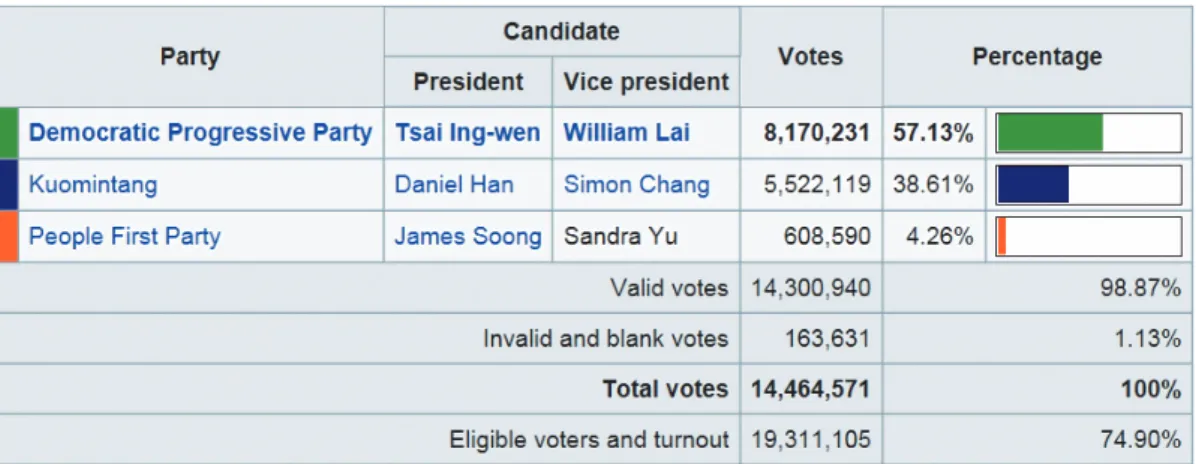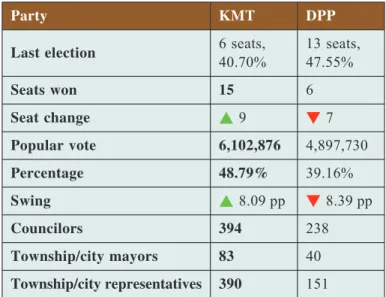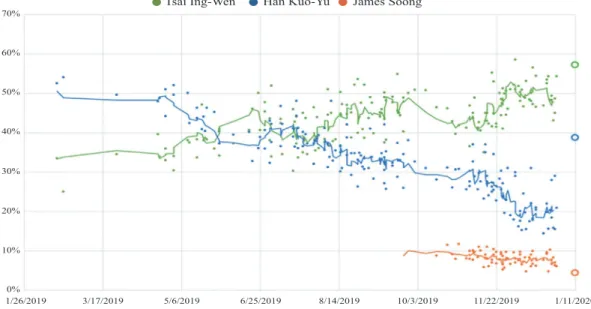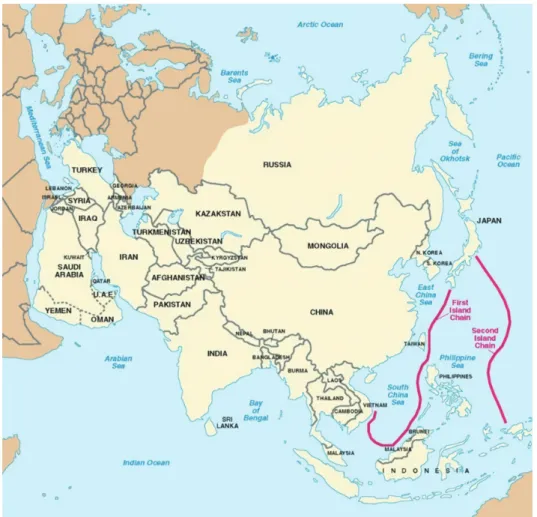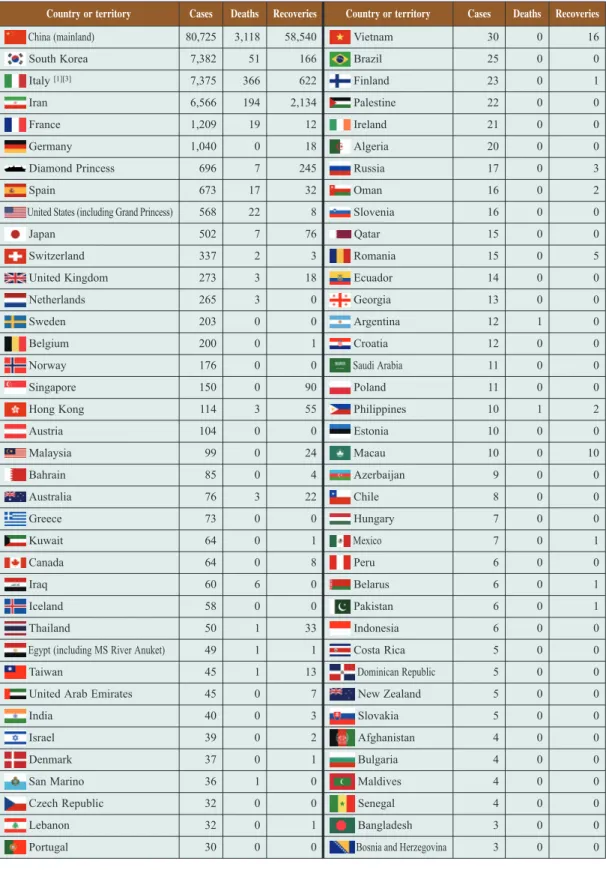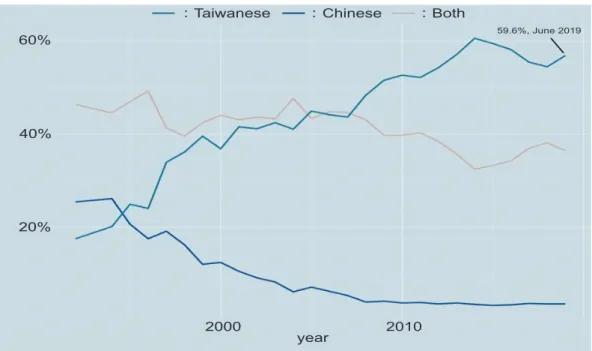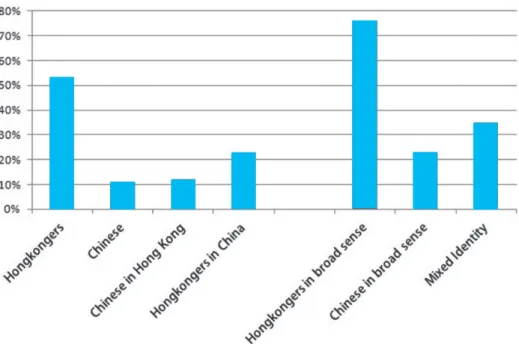The Prospects of Cross-Strait Relations
after Taiwan’s General Elections 2020
Jiann-fa Yan
Professor, Department of Business Administration, Chien Hsin University of Science and Technology
Abstract
China rising has posed a challenge to US hegemony since the early 2010s. The rising US-China confrontations have been a main factor affecting Taiwan-China or Hong Kong-China relations. China has been sanctioned and contained by the US in many aspects regarding traditional and new security issues. The US warned China not to interfere in Taiwan’s elections 2020 and to self-constrain in dealing with Hong Kong’s anti-extradition bill movements. Sharing the same hardship from China’s oppression, Taiwan and Hong Kong resonate with anti-Beijing sentiment. Hence, President Tsai Ing-wen won her second term by a wide margin of 8.17 million votes and the DPP legislative election results surpassed half of total seats. China completely failed. Furthermore, the outbreak of coronavirus has not only isolated and hurt China but also has made it notorious worldwide. China is riding on the back of a tiger. On the contrary, Taiwan’s progress in democracy and human rights has been praised highly as a glamorous model in Asia. More and more Chinese, inside or outside China, are seeing Taiwan as a lighthouse for their future. Taiwan’s democracy itself acts as a valuable treasure gaining more sympathy from the world in defending against Beijing’s annexation.
Keywords: US Hegemony, Tsai Ing-wen, Taiwan’s General Elections 2020, Hong Kong’s Anti-Extradition Bill Movements, Anti-Beijing Sentiments
I. The Underlining Factors Reshaping Taiwan’s Political Ecology
The Democratic Progressive Party (DPP) won a landslide victory in both presidential and legislative elections in 2020. In the presidential elections, incumbent President Tsai Ing-wen won her second four-year term, defeating her main competitor, Kaohsiung
Mayor Han Kuo-yu of the Kuomintang (KMT), by a wide margin: 8.17 million votes, or 57.13% of the total valid ballots cast vs. 5.52 million votes, or 38.61% (see Table 1). In the legislative elections, the DPP received 61 of the 113 seats, clearly surpassing half of the available slots, while the KMT received 38 (see Figure 1).
Table 1. The Results of Presidential Election, 2020
Source: Wikipedia, “2020 Taiwanese Presidential Election,” February 16, 2020, accessed, Wikipedia, <https://en.wikipedia.org/wiki/2020_Taiwanese_presidential_election>.
Figure 1. The Results of Legislative Election, 2020
Source: Wikipedia, “2020 Taiwanese Legislative Election,” February 16, 2020, accessed, Wikipedia, <https://en.wikipedia.org/wiki/2020_Taiwanese_legislative_election>.
Overturning the depressing frustrations in the nine-in-one elections in 2018 (see Table 2), the DPP’s overwhelming victory in the two-in-one elections dramatically reshaped Taiwan’s political ecology. Supposedly, the victory of the DPP resulted from favorable factors both externally and internally.
Table 2. The Results of Local Elections, 2018
Party KMT DPP
Last election 6 seats,40.70% 13 seats,47.55%
Seats won 15 6 Seat change ▲9 ▼7 Popular vote 6,102,876 4,897,730 Percentage 48.79% 39.16% Swing ▲8.09 pp ▼8.39 pp Councilors 394 238 Township/city mayors 83 40 Township/city representatives 390 151
Source: Wikipedia, “2018 Taiwanese Local Elections,” February 16, 2020, accessed, Wikipedia, <https://en.wikipedia.org/wiki/2018_Taiwanese_local_elections>.
1. External Factors
Since early 2018, China’s external relationships have turned sour, especially its strategic confrontations against the US. In economics, the gradual decoupling of US-China economy has made more and more Taiwanese businesses move out of US-China and turn to Southeast Asia or back to Taiwan, boosting Taiwan’s interior investments, which seems favorable to the Tsai administration in pursuit of a second term. In diplomacy, China’s intention to unilaterally change the status quo of cross-Strait relationships has pushed the US-Taiwan relationship closer. In security, China’s expansion of arms and the deployment of naval and air forces in the East and South China Seas, as well as its frequent exercises in penetrating the First and Second Island Chains, make the US more alert in safeguarding Taiwan’s capacities in defending the Taiwan Strait against China’s reckless aggression. In social and cultural exchanges, China wielding its sharp power has infiltrated Taiwanese society ubiquitously and endangered Taiwan’s democracy. In a word, China’s elaborate expansionism has challenged US hegemony and raised the US’ concerns about the joint security of its allies.
As a key node on the First Island Chain against Chinese expansionism, Taiwan’s strategic value has been gradually elevated. Clearly, in a certain sense, there exits higher degree of convergence in national interests shared by Taipei and Washington,
as well as Tokyo. The Trump administration had frequently sent Tsai administration supportive bills against China before the elections, especially the National Defense
Authorization Act for Fiscal Year 2020 on December 20, 2019. According to the Act,
“the Pentagon and the US Department of State are required to present reports within 180 days of the act’s implementation on reviewing the US’ Taiwan Relations Act and on Beijing’s influence over Taiwan’s security and economy as well as the cross-Strait balance.”
At the same time, the Anti-Extradition Movement alienated Hong Kong residents from a Chinese label in national identity. More and more Hong Kong residents were fearful of pervasive Beijing control that would obliterate their relatively unfettered rights under the 1997 formula of “One Country, Two Systems.” Hong Kong people’s sparking anger and anxiety has sent an alarm to Taiwanese worried that Xi Jin-ping’s proposal of “One Country, Two Systems Taiwan Formula (一國兩制臺灣方案)” gradually would bring Taiwan into the catastrophe already seen in Hong Kong. The imagination of this future of Taiwan had caused many Taiwanese young people to have a “feeling of demise,” which pushed them to vote for Tsai Ing-wen, whose image of fighting for sovereignty is very clear and firm (see Figure 2).
70% 60% 50% 40% 30% 20% 10% 0% 1/26/2019 3/17/2019 5/6/2019 6/25/2019 8/14/2019 10/3/2019 11/22/2019 1/11/2020
Tsai Ing-Wen Han Kuo-Yu James Soong
Figure 2. Opinion Polling for the 2020 Taiwanese General Election Source: Wikipedia, “Opinion polling for the 2020 Taiwanese general election,” February 16, 2020,
accessed, Wikipedia, <https://en.wikipedia.org/wiki/Opinion_polling_for_the_2020_ Taiwanese_general_election>.
2. Internal Factors
As a whole, China’s external relationships and related strategic management did not favor the pro-China KMT in the political arena. In addition, the KMT did not handle the election campaign well thanks to political cleavage among different factions inside the KMT. In nine-in-one local elections held on 24 November 2018, Han Kuo-yu unexpectedly raised a soaring populist faction, termed “Hanliu,” campaigning to revitalize Kaohsiung’s economic development by promoting opportunities of trade and tourism, especially from China. He pledged to promote Kaohsiung products, facilitate the inflow of money to the city, pay off the city’s debt, and invest in the future generations of Kaohsiung. He was able not just to turn out a usually dormant pan-Blue voting bloc in Kaohsiung, but also convinced many pan-Green voters to switch their votes. Finally, Han triumphed at the Kaohsiung mayoral elections on 24 November 2018, and became the first KMT Mayor of Kaohsiung since Wu Den-yih left office in 1998.
Nevertheless, Han did not fulfill his promise toward Kaohsiung citizens after he was inaugurated. He attempted to make good use of the upward momentum of “Hanliu” to promote himself to the higher level of the presidential one. On 15 October 2019, Han took a three-month leave of absence, dedicating himself to the presidential campaigns in 2020 despite facing enormous criticism from Kaohsiung citizens for serving only six months of his term in the city. Han formally was nominated as the Kuomintang presidential candidate on 28 July 2019. His nomination wiped out the opportunities of other hopeful KMT candidates and afterwards disappointed many loyal voters. The most crucial factor for his sliding rapidly is due to his false rhetoric and empty promises to the public. Clearly, Han’s triumph in the Kaohsiung mayoral election of 2018 did not cement the internal division of the KMT and also was not translated into supportive votes from middle voters and young people.
On the contrary, as a consequence, his representation of the KMT in the presidential elections not only messed up the tempo of the KMT’s original loop of the election campaign, but also brought about the chaotic impact on the given faction split inside the KMT. The KMT also faced serious criticisms for their pro-China public image in nominating two politically controversial legislator-at-large nominees, the retired lieutenant general Wu Sz-huai and retired Central Police University associate professor
Yeh Yu-lan. The former was criticized for not being opposed to the Communist party (CCP) and for going on Hong Kong media and laying out a military strategy for the PLA. The latter was blamed for her outcry expressing support for Hong Kong police while the police brutally opposed young students.
In a word, during the presidential and legislative elections campaigns, the KMT’s unification doctrine did not side with anti-China sentiments as mainstream thinking in Taiwan. In addition, strategic and tactical mistakes, rule-less power struggles inside the KMT, and the mismanagement of the Han’s political image all accounted for the landslide defeats of the elections compared with an incredible victory in the nine-in-one elections 2018, even though the KMT had a slight increase in the seats compared with 2016.
II. The Destiny of “One China”
1. The Hollow out of the Notion of “One China”
The notion of “One China,” either Beijing’s “One China Principle” or Washington’s “One China Policy,” has been a decades-long tacit understanding between the US and China, even though both have their different interpretations: China sees Taiwan as part of Chinese territory whereas the US claims it has its own definition of One China. Nevertheless, as China’s strength was on the rise in the mid-2000s, ranging from economic fields to military fields, the US has felt gradually challenged, especially in the Asia-Pacific region. China also sees the US as a hindrance for its outward development. Here, Taiwan’s status is raised up for its unique structural position and strategic value as the axis of the First Island Chain (see Figure 3). Besides, decades-long free elections, especially since the direct elections in 1996, have awakened Taiwanese national identity gradually drifting away from the thinking of Greater China arbitrarily defined by the KMT or the CCP.
Figure 3. First and Second Island Chains
Source: Wikiwand, “First island Chain,” February 16, 2020, accessed, Wikiwand, <https://www. wikiwand.com/en/First_island_chain>.
As time passes, the substance of Republic of China (ROC) has become more Taiwanese than Chinese, as the DPP’s definition: Taiwan is an independent sovereign country with its constitutional name called Republic of China; the ROC and the PRC are exclusively separated from each other. On 10 October 2019, President Tsai claimed “Republic of China Taiwan” as an independent country in her presidential speech. In this regard, Tsai’s winning a record-breaking 8.17 million votes, 57.13% of the total valid ballots cast, in a sense, can be interpreted as a referendum for “Republic of China Taiwan.”
2. China’s Sharp Power Exacerbates the Hollow-out of “One China”
In 2014, Xi announced, “We should increase China’s soft power, give a good Chinese narrative, and better communicate China’s messages to the world.” As Joseph Nye defines it, soft power is the ability to attract and convince rather than coerce others. Soft power is manifested in the fields of culture, political values, and foreign policies; credibility is the core issue concerned. Nevertheless, with the rise of China’s authoritarian expansionism, “sharp power” was invented to replace “soft power,” by National Endowment for Democracy in 2017. China, as a typical example, has elaborately tried to exercise aggressive and subversive policies to project its state power into democratic countries by virtue of manipulating information in the news media and educational systems of the targeted countries for the purpose of misleading or dividing public opinion so as to weaken and make them surrender.
Certainly, other than the US, Taiwan is the main target. China has attempted to selectively wield its flags of authoritarianism by manipulating or distorting the information to reach divided Taiwan. China not only seeks to win the hearts and minds of pro-unification liners, but also tries to extend its target audiences. Taiwan is China’s main and long-term target. Nevertheless, except for Taiwan, Australia is the first one in international society overtly to reveal China’s tactics in interfering in Australian politics, universities, and publishing, finally influencing its lawmaking process. Afterwards, Britain, Canada, New Zealand, and the US also started to raise the alarm. In Taiwan, Beijing has never given up opportunities to subvert the ruling DPP. Since President Tsai Ing-wen was inaugurated 20 May 2016, Beijing shut all the official channels across the Taiwan Strait. Nevertheless, Beijing has never closed its doors to the Blue camp; it even tried very hard in promoting socio-economic exchanges between China and the Blue-ruled areas as well as pro-unification groups and individuals. Beijing also poured enormous resources into penetrating Taiwan through its Fifth Columns all over Taiwan Island. The internet technology and social media had become very important channels for China to spread disinformation and fake news undermining the credibility and reputation of the ruling DPP government. Beijing was very successful in handling them in the “nine-in-one” local elections 2018 and dramatically made Taiwan’s landscape turned its color back to Blue from once-dominant Green.
In the nine-in-one elections in 2018, the DPP government suffered a crushing defeat partly due to the decades-long stagnant economy and some strategic mistakes made in the socio-economic reforms, including labor reforms, pension reforms, and same-sex marriage; the nuclear plant issue; and so forth. The complaints derived from Tsai’s reforms have alienated a great many people from the DPP camp and pushed a lot of disgruntled voters firmly into the KMT camp, even though there was no real suggestion that the KMT could reverse the policy. During the election campaigns, Beijing played a role in mobilizing protesters and spreading disinformation about Tsai’s mismanagement of the reform issues via electronic media and the Internet. Various web sites have been used to disseminate “fake news” about the government’s policies and performance.
The national security units confirmed that the information originated in China. Beijing was suspected of generating and spreading disinformation by means of ‘content farms,’ maligning Tsai’s credibility and ability regarding the reform issues, especially pension reform plans. For the supporters of the Blue camp and some middle voters, they stereotypically perceived Tsai’s talks or behavior from a negative view. Even though some information finally was clarified, many people were still discussing it as if it were true.
Nevertheless, over the past few years, Taiwan has not been the only victim with its democracy, governance, and internal cohesion being disturbed and damaged by China’s sharp power; the western like-minded countries also have suffered. The US
National Strategy Report published in December 2017 turned China from a strategic
partner into a strategic competitor. In order to broaden the international front against Chinese influence operations and investments, starting in October 2018, the increased cooperation by the Five Eyes alliance - grouping Australia, Britain, Canada, New Zealand, and the United States - with countries such as Germany and Japan has been very active.
From a geostrategic view, China’s authoritarian expansionism has become a common threat against democracies, including Taiwan. For national interests, the US tended to take a unilateral approach in helping Taiwan get rid of China’s interference in the 2020 elections. The Taiwan Travel Law signed 16 March 2018 was to support the exchange of high-level officials between the two countries. National Defense
Authorization Act for Fiscal Year 2020, signed 20 December 2019, safeguards Taiwan
as a vital partner critical to a free and open Indo-Pacific region and reaffirms U.S. commitment to the Taiwan Relations Act and Six Assurances. Taiwan-US cooperation on cyber-security is also to be enhanced, and the US defense secretary has to submit a report on the feasibility of establishing a high-level, interagency working group in this regard.
Clearly, Taiwan, as the hub of the First Island Chain and a model of western democracy, shoulders an important strategic role and function in the “Indo-Pacific Strategy” advocated by Trump during his first term. Hence, the threats derived from Chinese authoritarian expansionism not only jeopardize Taiwan’s security but also undermine the interests of the US and its democratic allies. From a realistic view, for the stakeholders in this region, the so-called “One China” will not be an unbreakable faith, not to mention that the US reiterates its own definition of “One China.” The coming fierce challenges from Red China have ignited strong anti-Chinese sentiments on a bipartisan basis in the US. Confronting US’ interests in maintaining the status
quo in the Taiwan Strait, Xi Jin-ping’s proposal of “One Country, Two Systems Taiwan
Formula,” as creeping unification, would cross the red line set by the US. Under these circumstances, One China will be a hollowed-out notion incompatible with the political reality unless China could eventually defeat the US militarily.
III. The Creeping Disillusion of the China Dream
As former Chinese Premier Wen Jiabao once said: “If you gauge China’s problems with multiplication, a small problem in China multiplied by 1.3 billion may become a big one.” The rapid growth of Chinese economy in the 2010s allowed the Chinese model to take its sights, whereas the outbreak of Wuhan coronavirus 2019-2020 made the image of the Chinese model completely collapse and become notorious (see Table 3). The Chinese government’s delay of informing the world about the disease and its ruthless blockage of Taiwan’s participation of the WHO also angers most Taiwanese people and widens the social and psychological distance between the two sides.
Table 3. China’s Notorious Outbreak of Corona Virus, as of 9 March 2020, 09:30, a.m.
Country or territory Cases Deaths Recoveries Country or territory Cases Deaths Recoveries
China (mainland) 80,725 3,118 58,540 South Korea 7,382 51 166 Italy[1][3] 7,375 366 622 Iran 6,566 194 2,134 France 1,209 19 12 Germany 1,040 0 18 Diamond Princess 696 7 245 Spain 673 17 32
United States (including Grand Princess) 568 22 8
Japan 502 7 76 Switzerland 337 2 3 United Kingdom 273 3 18 Netherlands 265 3 0 Sweden 203 0 0 Belgium 200 0 1 Norway 176 0 0 Singapore 150 0 90 Hong Kong 114 3 55 Austria 104 0 0 Malaysia 99 0 24 Bahrain 85 0 4 Australia 76 3 22 Greece 73 0 0 Kuwait 64 0 1 Canada 64 0 8 Iraq 60 6 0 Iceland 58 0 0 Thailand 50 1 33
Egypt (including MS River Anuket) 49 1 1
Taiwan 45 1 13
United Arab Emirates 45 0 7
India 40 0 3 Israel 39 0 2 Denmark 37 0 1 San Marino 36 1 0 Czech Republic 32 0 0 Lebanon 32 0 1 Portugal 30 0 0 Vietnam 30 0 16 Brazil 25 0 0 Finland 23 0 1 Palestine 22 0 0 Ireland 21 0 0 Algeria 20 0 0 Russia 17 0 3 Oman 16 0 2 Slovenia 16 0 0 Qatar 15 0 0 Romania 15 0 5 Ecuador 14 0 0 Georgia 13 0 0 Argentina 12 1 0 Croatia 12 0 0 Saudi Arabia 11 0 0 Poland 11 0 0 Philippines 10 1 2 Estonia 10 0 0 Macau 10 0 10 Azerbaijan 9 0 0 Chile 8 0 0 Hungary 7 0 0 Mexico 7 0 1 Peru 6 0 0 Belarus 6 0 1 Pakistan 6 0 1 Indonesia 6 0 0 Costa Rica 5 0 0 Dominican Republic 5 0 0 New Zealand 5 0 0 Slovakia 5 0 0 Afghanistan 4 0 0 Bulgaria 4 0 0 Maldives 4 0 0 Senegal 4 0 0 Bangladesh 3 0 0
Luxembourg 3 0 0 Malta 3 0 0 North Macedonia 3 0 0 South Africa 3 0 0 Albania 2 0 0 Cameroon 2 0 0 Latvia 2 0 0 Morocco 2 0 0 Tunisia 2 0 0 Cambodia 2 0 1 Armenia 1 0 0 Bhutan 1 0 0 Colombia 1 0 0 Jordan 1 0 0 Liechtenstein 1 0 0 Lithuania 1 0 0 Moldova 1 0 0 Monaco 1 0 0 Nigeria 1 0 0 Paraguay 1 0 0 Serbia 1 0 0 Togo 1 0 0 Ukraine 1 0 0 Vatican City 1 0 0 Andorra 1 0 1 Nepal 1 0 1 Sri Lanka 1 0 1 Total territories (108) 109,835 3,803 60,695
Source: Wikipedia, “Template: 2019-20 Wuhan corona virus data,” March 9, 2020, accessed,
Wikipedia, <https://en.wikipedia.org/wiki/Template:2019%E2%80%9320_Wuhan_
coronavirus_data>.
Beginning in the mid-2000s, China’s peaceful rise amazed the world as a developmental miracle and the “China model” became a hot issue in academics and politics. State Councilor Dai Bingguo, in May 2010, proposed “A New Type of Great Power Relations” (NTGPR) for the US-China relationship during the second round of the Sino-US Strategic and Economic Dialogue, suggesting that China and the US should “create a new type of great power relations regarding different social systems, cultural traditions, and stages of development with mutual respect, harmonious and win-win cooperation during the era of globalization.”
China proposing the initiative reflects its rise to higher status ever since early 2000. Owing to the involvement of the wars in Afghanistan and Iraq, the US economy started to decline whereas China had very amazing economic performance: China became the number one foreign reserve holder, replacing Japan, in 2006; and it became the number two economy in the world, replacing Japan, in 2010. The US was trapped in the wars whereas China was expanding its presence and influence in the areas of global affairs covering diplomacy, economics, military, and so forth. China had been silently laying out its global strategic map. In contrast to China’s success and its growing clout, western liberal democracies seemed failing whereas the China model became an alternative to liberal democracy in governance.
On 18 October 2017, Xi pledged to build a strongest and the most powerful socialist country in the world in the political report of the 19th Chinese Communist
Party Congress. This sends a strong message to the world that China is very much ambitious to rise and consequently turns the given international order into a different one framed by a socialist system. It would change the world dominated by the West for almost four to five hundred years if the China dream came to be true.
Unfortunately, Xi’s spuriously appraised “China dream” met Trump’s “Make America Great Again.” Trump is a tough and strategic pragmatist fighting to win. He understands that Chinese leaders are apt to compromise in dealing with their harder counterparts during the political bargaining; before being too late, he should not stop his fists until China is knocked down to the floor. Besides, behind Trump there exists a strong moral ground that China has not played by fair rules with the US. Being accused of “systematic theft” of US weapons systems, the illicit transfer of dual-use technology, and a government-subsided economy, China’s strengths have upset the US. Besides, China’s “proactive and coercive” ways of meddling in the US midterm elections in September 2018 are also intolerable to Trump.
Ever since March 2018, centered on trade wars, US-China confrontations have occurred in almost every sphere of life. The mode of Sinophobe in the US has become bipartisan. The US mistrust and ceaseless pressure against China largely has paralyzed China’s Manufacturing 2025 as well as its economic and financial conditions, and even frustrated Xi’s vision of a China Dream. Crippled by US’ trade sanction, ZTE and Huawei, two Chinese technology giants, were almost paralyzed. The myth of a China model was fundamentally disenchanted.
The China dream to accomplish the historical mission of unification almost dissipated. An endless series of huge and violent protests in the name of Anti-Extradition beginning April 27 in Hong Kong cast a long shadow over Beijing’s projection of national unity and power, undoubtedly destroying the feasibility of Xi’s proposal of “One Country, Two Systems; Taiwan Formula” designed for Taiwan addressed on 2 January 2019. Resonating with waves of endless protests in Hong Kong, there rose growing anti-Chinese sentiments in Taiwan (see Figure 4). The slogan of “Today’s Hong Kong, Tomorrow’s Taiwan” worried most Taiwanese, especially young people. A strong sense of being subjugated by China had aroused voters’ enthusiasm to vote
for Tsai who bravely could reject China’s One China principle. 60% 40% 20% 2000 2010 year
Taiwanese Chinese Both
59.6%, June 2019
Figure 4. Changes in Taiwan’s National Identity, 1992-2019
Source: Yeh Su-ping & Chung Yu-chen, “Taiwanese identity rises for the first time in four years: poll,” Focus Taiwan, July 11, 2019, <https://focustaiwan.tw/politics/201907110012>. Clearly, in the wake of US-China confrontations, there have come up trade and technology wars, South China Sea confrontations, debating of religious and human rights issues, China’s mismanagement of swine plague, real estate bubble, haze pollution, coronavirus outbreak, and so forth. Above all, the virus outbreak and rapid spread have demonstrated once again that Xi’s over-centralized administration lacks the capacity to deal with special situations and lacks a bright mindset and culture in cooperating with the international community. China’s reputation in public health has been severely damaged, and China also has hurt its own economy and impacted the world economy. Banned by many countries, Chinese tourists have become unwelcome around the world. Over years, the China model, underpinned by party-led authoritarianism, has shown its strength to achieve the goals set by rigid top-down plans or frameworks at the expense of undermining the organic vitality and flexibility of individuals. The coronavirus further pushed Taiwan to a new world drifting away from China.
IV. Xi Jinping’s Predicaments and Options for His Taiwan Policy
1. Xi Jinping’s PredicamentsIn the wake of Taiwan’s general election 11 January 2020, Hong Kong will hold Legislative Council elections in September and the US presidential election will be held in November. Under such a journey, in order not to offer Hong Kong and the US munitions during election campaigns, it is difficult for Beijing to adopt a policy of “radical containment or aggression” towards Taiwan. At the same time, the disasters originating in mismanagement of the coronavirus alone will definitely not only exhaust Beijing leadership but also make worse those chronic problems stated above. Furthermore, Hong Kong’s appeals for universal suffrage also will be a long-term battle to fight for Beijing.
2. Xi Jinping’s Options for the Taiwan Policy
It is foreseeable that 2020 will be a busy and difficult year for China. Under these circumstances, Taiwan may pay more attention toward internal affairs and international networking. In order to avoid further stimulating anti-China sentiments in Hong Kong, Taiwan, and the United States, Beijing would neither relax its basic policy of “One China” nor tighten its grip on “One China.” It might continue to follow the existing “unilateralism,” which includes “attracting more and more Taiwanese into China to work, to live, or to study” and “joining the blue camp fighting against the green one.”
Reviewing the past few years of Xi’ administration, the ways China could or would have manipulated its sharp power over Taiwan have been varied and flexible. (1) A rhetorically firm stance on One China Principle; (2) a low profile response toward US provocation; (3) conducting divide-and-rule or carrot-and-stick tactics toward Taiwan society; (4) conducting three wars: legal, media, and psychological; (5) to mess up Taiwan society by fake news; (6) to dispatch the Fifth Columns penetrating every corner of Taiwan society; (7) inciting internal confrontations in every sphere of life; (8) increasing Taiwan’s social and economic dependence on China; (9) alienating Taiwanese from Americans or Japanese; and (10) further suffocating Taiwan’s international living space are some methods. In a sense, Taiwan’s
freedom, as strength of a democracy, also exposes itself to China’s easy access, free penetration, and incessant destruction of Taiwan’s internal harmony and stability.
V. Taiwan’s Options in Face of China’s Annexation
During the elections, Beijing racked its brains to find ways to pull the DPP down. Manipulation of the fragility of the human mind is one of the ways for Beijing to influence Taiwanese voting behavior. Beijing has skillfully used “psychological and media warfare” strategies, as well as economic interests, to undermine the Taiwanese people’s morale, confidence, and trust in the pro-independence government. On the other hand, inside China, Beijing authorities also have attacked Taiwanese independence by manipulating nationalism. Beijing often states Taiwanese independence means a war across the Taiwan Strait. It also has been speculated that Beijing might divert internal pressure by triggering a war against the emergence of Taiwan independence. Nevertheless, most of the Taiwanese, with the US’ strong support, believe that it is more an exercise of psychological intimidation; if warfare broke out across the Taiwan Strait, it would not be just a war for Taiwan, but for the entire Asia-Pacific region, consequently leading the region into social and political turmoil. Hence, neighboring countries will not sit idle and watch it happen. Learning from past experience, Taiwanese people understand that there is no need to worry about China’s use of force if Taiwan is not tempted towards provocation. As a matter of fact, compared to getting involved in an uncertain war, Xi would rather trigger a civil war at lower cost if necessary.
In contrast to China’s verbal domination, again, the presidential elections in 2020 broke the myth of China’s sovereign claim over Taiwan. Driven by the engine of elections, the distance between Taiwan and China has become wider and wider.
Elections themselves as mechanism to express people’s voices naturally will lead Taiwan, as well as Hong Kong, away from China’s demands. As a political process, elections help a society foster its own political and cultural identity. More elections make Taiwan, as well as Hong Kong (see Figure 5), more distinct from China. Above all, due to growing demand of international participation, more and more Taiwanese have become conscious of their own Taiwanese identity, thanks to China’s blockage
and suppression in the world arena.
Figure 5. More Cantonese Speakers in HK Identify as ‘Hongkonger’ than ‘Chinese’, June 2019
Source: Zin Kao, “‘Hongkonger’ identity at highest since 1997,” Taiwan News, June 28, 2019, < https://www.taiwannews.com.tw/en/news/3734105>.
VI. Conclusion
China now is at the crossroads: either to smash Taiwan’s independence forces immediately at the expense of Chinese national development, along with provoking US-led allies to get involved, or to negotiate with the DPP government at the expense of giving up the “One China Principle.” In such a dilemma, bluffing, mixed with a carrot-and-stick approach, remains an easier and more convenient way for Beijing to cheat or confuse its enemies into conceding in the long run. Nevertheless, just as Tibet’s spiritual leader, Dalai Lama, asserted that “The Chinese had initially a tough reaction, but then it can go smoothly,” tactically speaking, for the DPP government, insistence on principle is still the best way to cope with Beijing’s united front tactics. On the contrary, a weak, instead of soft, approach gradually may accommodate Taiwan to China’s expansionism and China’s endless claims of sovereignty over Taiwan; it will make things become more complicated and worse. It will also make Taiwan’s
globally democratic leverage against Chinese authoritarianism weakened and likely defeated.
Along with strategies, tactics, or modes of thought, structural configuration matters. The US goal in Asia has been to prevent any single power from dominating Asia. The American unilateral way of thinking towards regional affairs will not vanish. China’s strong ambition to dominate Asia contradicts basic American interests. In a word, Xi’s notion of “China Dream” will not fit with Trump’s “Make America Great Again.” If Trump were to be reelected 2020, Trump might take a harder approach against China so as to pursue his historical status.
In concert with US’ national interests, Taiwan’s progress in democracy and human rights has been praised highly as a successful and unique model to create new fusion of traditional and modern values in Asia. More and more Chinese, inside or outside China, are looking forward to seeing Taiwan’s today be China’s tomorrow. Taiwan’s model for democracy has become a best weapon for Taiwan to defend itself from Beijing’s annexation.
